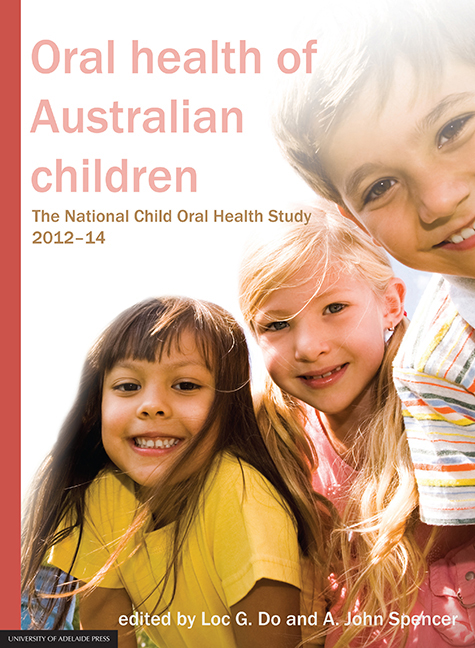Book contents
- Frontmatter
- List of Contributors
- Contents
- Preface
- Executive Summary
- 1 Children's oral health – assessing and improving oral health
- 2 Measuring child oral health and its influences
- 3 Data weighting, consideration and estimation procedures
- 4 Measuring representativeness of the study participants
- 5 Children's oral health status in Australia, 2012–14
- 6 Patterns of dental services use by Australian children
- 7 Australian children's oral health behaviours
- 8 Australian children's general health behaviours
- 9 Social gradients in child oral health
- 10 Oral health status and behaviours of Indigenous Australian children
- 11 Trends in child oral health in Australia
- 12 Interpretation of findings and a way forward to improving oral health and dental care
- 13 Appendix
- State and territory survey personnel
- Symbols
- Abbreviations
- Place names
- Glossary
- List of tables
- List of figures
10 - Oral health status and behaviours of Indigenous Australian children
Published online by Cambridge University Press: 05 September 2017
- Frontmatter
- List of Contributors
- Contents
- Preface
- Executive Summary
- 1 Children's oral health – assessing and improving oral health
- 2 Measuring child oral health and its influences
- 3 Data weighting, consideration and estimation procedures
- 4 Measuring representativeness of the study participants
- 5 Children's oral health status in Australia, 2012–14
- 6 Patterns of dental services use by Australian children
- 7 Australian children's oral health behaviours
- 8 Australian children's general health behaviours
- 9 Social gradients in child oral health
- 10 Oral health status and behaviours of Indigenous Australian children
- 11 Trends in child oral health in Australia
- 12 Interpretation of findings and a way forward to improving oral health and dental care
- 13 Appendix
- State and territory survey personnel
- Symbols
- Abbreviations
- Place names
- Glossary
- List of tables
- List of figures
Summary
Chapter 10 compares the oral health and behaviours of various groupings within the population of Indigenous children. Differences are examined by sex, parental education, household income, residential location and reason for last dental visit.
Indigenous people in Australia have the poorest health outcomes. Indigenous children also have poorer health outcomes than their non-Indigenous counterparts (Australian Bureau of Statistics 2014). These have been related to social disadvantage. However, within the Indigenous population there is variation in social status. This chapter explores that social variation in relation to oral health status and oral health behaviours.
Indigenous identity data was collected using the Australian Bureau of Statistics (ABS) question ‘Are you of Aboriginal or Torres Strait Islander origin?’ Responses that the child was ‘Yes, Aboriginal’, ‘Yes, Torres Strait Islander’ or Yes, Torres Strait Islander and Aboriginal’ meant the child was classified as Indigenous.
Oral health status of Indigenous children
Oral health status was measured using both the prevalence in the population and the average number of tooth surfaces with dental decay experience. This was categorised into the following elements: untreated decayed surfaces, missing surfaces due to decay and surfaces filled due to decay. Both the primary and secondary dentitions were examined and are reported separately.
In this chapter on the oral health of Indigenous children, the age groups on which data are reported differ from those in Chapter 5. This difference was due to the insufficient numbers of Indigenous children in the study to report on two-year age groups. For caries experience in the primary dentition the tables report on children aged 5–9 years and for the permanent dentition 9–14 years.
Caries experience in the primary dentition
Table 10-1 shows the average number of tooth surfaces with untreated decay, missing due to decay and filled surfaces and the average total number of affected surfaces (dmfs) by sociodemographic factors for Indigenous children aged 5–8 years. The average number of tooth surfaces decayed, missing or filled gives an indication of the severity of the disease, the burden it makes for the child and reflects access to timely dental care. Each tooth was divided into five surfaces and each surface decayed or filled was counted, but each missing tooth was counted as three surfaces.
- Type
- Chapter
- Information
- Oral Health of Australian ChildrenThe National Child Oral Health Study 2012-14, pp. 264 - 287Publisher: The University of Adelaide PressPrint publication year: 2016



